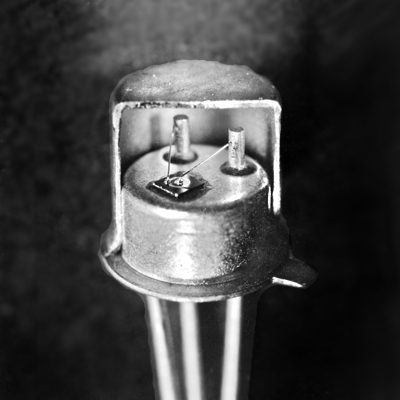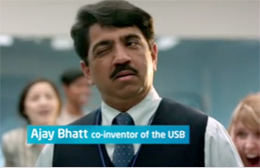Friday, May 8th, 2009
Today, Intel sponsored a history of the planar IC event at the Computer History Museum, in Mountain View, California. This, in the same week that the company pre-launches a new advertising campaign to try to position the company as “Sponsors of Tomorrow.” Based on the live event, the past was seriously wonderful. Based on these new commercials, the future will be “of a quirky, tongue-in-cheek nature,” but that may be just what the world needs right now. Gordon Moore and Jay Last, giants who stood on the shoulders of giants, gave wonderful presentations at the event about how they invented much of IC processing 50 years ago.
The planar IC has been the foundation of the modern electronics era. Discrete semiconductors had been in commercial production for a decade when, in 1959, visionaries such as Jack Kilby (TI) and Robert Noyce, Jean Hoerni, and Jay Last (all at Fairchild) created the IC.
Compared to the prior art of the “mesa” transistor, Hoerni conceived of the use of grown oxide to protect the top surface. The military was the main customer for an NPN mesa transistor (where particles shorted out transistors), while oxide passivation protected the surface resulting in high reliability with improved amplification and switching characteristics. “Jean was said to have demonstrated the first planar transistor by spitting on it to prove the reliability,” said Gordon Moore. However, the fab process was very difficult, and took a full year of pilot line work. After the planar transistor was proven (see figure), it was only a matter of time before planar processes were found for other circuit elements and the IC happened. In fact, multiple independent groups in the world developed IC building blocks that were nearly identical in concept.
Establishing the planar process saved Fairchild’s business, and ushered in silicon as the main material for semiconductor electronics. However, the company first had to sell chips at a loss and make up for it in volume. Seriously. In the early 1960s, one transistor on an IC might cost $150, while a discrete cost $3. After success in selling ICs to the military, in 1964 the technologist turned business visionary Robert Noyce decided that Fairchild should drop prices below fab costs to capture the first commercial IC business. In less than a year, the company received a single order that was equal to 20% of the value of the entire commercial industry in the prior year. “He started what has become the standard for the semiconductor industry: the solution to all problems is to cut the price,” quipped Moore. “The rest, I guess, is history.”
Gordon Moore was the director of R&D at Fairchild when the planar transistor was invented. Jay Last led R&D when IC process integration first occurred in a fab, and he spoke of it as a historic inevitability, based on prior developments in science and engineering. Fairchild was trying to make products that could make money, and so they were very focused on target applications, enabling technologies, and innovations in manufacturing. “In one way, you could say that we did for Silicon Valley what Henry Ford did for Detroit,” said Last. The proof-of-concept for the planar IC required low-yield and high-cost processing, including an isolation flow that resembles today’s state-of-the-art in packaging.
The first successful planar IC made in a batch process, involved bonding the silicon wafer face-down to a quartz “handle” wafer, thinning to 75 microns, backside etch through a mask to remove all silicon down to the surface oxide (to here, this could be a through-silicon-via flow), and then a backfill of some dielectric material. Double-sided alignment was done using IR. In late 1960, a methyl-borate source allowed for an 18-hour Boron diffusion process for isolation, and by the end of 1961 the first commercial IC was for sale using bipolar transistors. The only fundamental change since has been the introduction of the MOS transistor.
A question from the audience at the Computer History Museum was, “Can we reinvent Silicon Valley to make it an exciting place like it was in the 1950s?” Tellingly, there was complete silence from Last and Moore, and so the moderator moved on to another question.
The future of Silicon Valley will be left to marketeers, as evidenced by the “Sponsors of Tomorrow” web page. Intel hired actors to play the real Intel employees. The absurd “Rock Stars” commercial supposedly stars Ajay Bhatt (see figure, below) who was one of the inventors of the universal serial bus (USB) standard. “Several of the engineers we’re personifying confided that acting isn’t within their comfort zone,” said Sandra Lopez, Intel’s global consumer marketing manager. Poor Ajay Bhatt is thus denied his real “15-minutes-of-fame” by an actor with a bad haircut and annoying mannerisms (see figure, above).
The ad campaign tries to convey the idea that gigantic advances of the digital age have been made possible by silicon – and the vast majority of this silicon has come from Intel. “Our image, our brand are far too powerful to just be a microprocessor when, in fact, the greatest strength of the Intel brand will always be what is still to come,” said Deborah Conrad, Intel vice president and general manager, Corporate Marketing Group. “What Intel develops today leads the path toward a better tomorrow.” Maybe a radical new silicon technology will lead the way into the future, such as a sensor-FET out of Intel Fab8 in Israel, or some optical IC out of a secret lab.
Despite the appeal of an ideal future, we have to work in the real present, and try to sell products now. Perhaps consumers will be amused by garish parodies of engineers. Perhaps a sly wink is what will move more chips. Perhaps the “Intel inside” campaign showed that you can build consumer brand equity in the IC business, and so this is just the next step in positioning. “A heavy internal campaign is already underway at Intel campuses throughout the world,” said the press release. –E.K.



